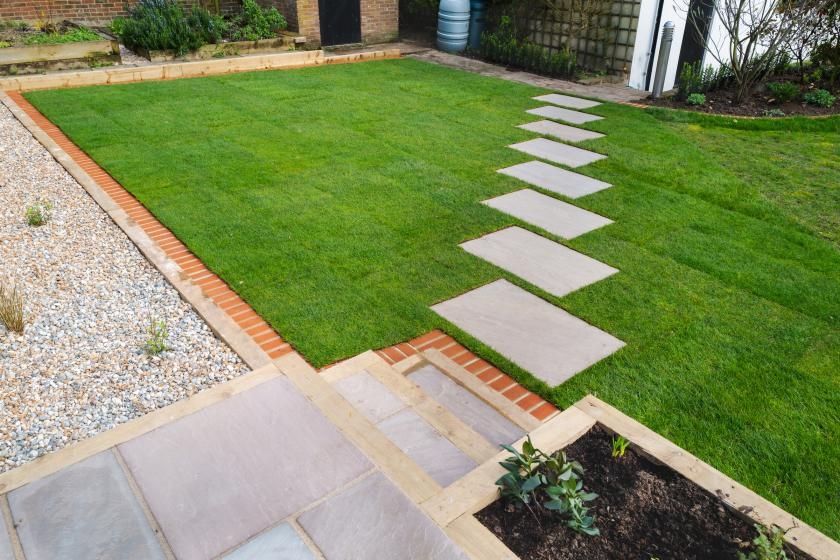The stone path is one of the oldest forms of paved surface and it is still in use today because it works. It’s a simple and practical way to create a walkway across your landscape. If you want to direct foot traffic and protect your grass, while adding rustic but functional charm to your home’s curb appeal, look no further. You only need to know how to create a stepping stone path. Keep reading to learn how.
Step 1. Map it Out
Choose a spot. Decide where you want your path to begin and where it should end. The path can travel in a straight line or be curved. You can use a garden hose as a guide to chart the shape and direction of the path.
Helpful Tip
Spray landscaping paint on the grass along the outside edge of the hose to mark the path’s outer perimeter. Let the paint dry and then put the hose away.
Using a measuring tape, determine the length of your path. This will help you to decide how many stones you will need—and it will figure in to how much distance will be between each one. Stand where you want the walkway to begin and take a step forward in your natural stride. Push a stake into the ground beside the midpoint of your foot. This will be the center of the stone. Measure this distance and then from that point add another stake at that same distance for the next stone center. Repeat until you’ve reached the proposed endpoint of the path.
Step 2. Acquire or Create Stones
Before you move forward, you need stones for your path. You have a couple of options. The type of stones you need may be purchased from a landscaping supplier or you can find them yourself in the wild. Depending on how many stones you need for your walkway, transporting the stones to your home and moving them around your yard can be an additional burden; they can be heavy…and expensive.
The other option is to make them yourself using concrete mix and some type of mold. The Quikrete® Walkmaker® is a reusable plastic mold specifically for DIYers to create their own pathways. You can also build your own mold to shape the stones to your liking, using scrap pieces of wood or an old baking pan.
To build a mold from wood, you can use 2x4s and a sheet of plywood, cut in your desired dimensions, such as 13” a side. Connect the pieces at each corner with wood screws and an electric screwdriver. Then cut a piece of plywood to fit and screw it to the 2x4s to create a back panel. Make a handful of these forms to speed up the stone-making process.
Helpful Tip
Circular or square baking pans can make great molds. Before filling the pans with concrete mix, be sure to coat the inside of them with some type of lubricant, such as cooking spray for easy removal of the stones after they set.
Mix concrete with water in a wheelbarrow or large bucket, following all package instructions. Wet your mold with a little bit of water (or cooking spray if you’re using a pan) and then pour the concrete mix into it.
Safety Alert!
Whenever you’re working with cement powder, always wear a dust mask, protective goggles and gloves. Avoid contact with your skin and eyes. If you get any wet cement on your skin (either through direct contact or wet clothing), wash the area well with fresh water and remove your soaked clothing immediately. Always keep all of your materials and equipment away from children and pets.
Use a mason’s float (or the edge of a piece of wood) to scrape off excess concrete from the top of the mold and smooth the surface. This is more than just a cosmetic procedure — it also floats any fine particles and air bubbles to the surface, creating a denser, more durable top layer.
Let the concrete stone cure for the length of time recommended by the concrete manufacturer. When the concrete has set, remove your new stone from the mold and set it aside. Repeat the process for subsequent stones until you have enough of them to complete your path.
Step 3. Prepare the Path Site
Lay the stones down in place to get an idea of how the path will look. If you are happy with the layout, leave the stones on the grass for a couple of days. This will brown the grass underneath, leaving perfect outlines of the stones. Set the stones aside and cut around the edges of each outline with a garden trowel and remove the sod from inside the area. Remove about 2” to 4” of soil from the area (depending on the thickness of your stones) and then pack the area down using a tamper, so it is flat and close to level.
Safety Alerts!
When lifting and moving stones, bend your knees and lift with your legs to avoid potential injury.
Wear heavy boots and work gloves when handling steppingstones.
Add a 1” to 2” layer of crushed limestone, pea gravel or sand into each hole for drainage, and then pack it down with the tamper.
Step 4. Lay the Stones
Place the stepping stones in their respective places and walk along your path a few times. Take time to stand on each stone for a few seconds to tamp them down further and help them settle into the ground. Check that your stones are aligned by laying a board from one stone to another and placing a level on it. Adjust the stones as necessary. Make sure the stones sit without wobbling or lifting, when stepped on.
That’s it! Enjoy your new stone walkway.
Project Shopping List
Here’s what you’ll need to complete this project successfully.
- Garden hose
- Landscaping paint
- Measuring tape
- Stakes
- Stones (optional)
- Concrete mix
- Quikrete® Walkmaker® (optional)
- Baking pan (optional)
- 2x4s
- Plywood
- Wood screws
- Electric screwdriver
- Circular saw
- Cooking spray
- Wheelbarrow or large bucket
- Dust mask
- Protective goggles
- Gloves
- Mason’s float
- Garden trowel
- Tamper
- Heavy boots
- Work gloves
- Crushed limestone, pea gravel or sand












